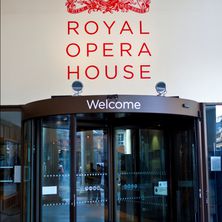

The largest building looking onto the Covent Garden market piazza today is the Royal Opera House – home not only to the Royal Opera, but also the Royal Ballet. The present building dates from 1732, although it has been enormously expanded and altered from the original designs by architect Edward Shepherd. Fires were a permanent hazard in theatres lit by candles or oil-lamps, and fires in 1808 and 1857 prompted extensively rebuilding by Edward Barry in 1858. Regrettably the last of the baroque 'homes for gentlemen' designed by Inigo Jones for Covent Garden were also lost in the 1857 fire, and were not rebuilt – instead the opera house expanded over the ground upon which they once stood. Even so, the present appearance of the Royal Opera House was only reached in 1997, when a multi-million pound rebuilding program incorporated the former flower market, Floral Hall, into the opera-house complex. The market had finally become the opera-house itself. There had previously been a sequence of wooden theatres on the site where Shepherd's palladian-style theatre was built in 1732. The owner of the last wooden theatre was a theatrical impresario named John Rich, who made his fortune in 1728 presenting a lampoon of Handel's style of Italian opera, called “The Beggar's Opera” - in English, with popular tunes, and with a gritty storyline about thieves, pickpockets and courtesans. The music was by the composer John Gay, and people said this smash-hit sensation “made Rich gay, and Gay rich” - in the days when 'gay' still meant 'cheerful', of course. The show ruined Handel, whose operas went into a nosedive with the public. Ironically Handel then had to come on bended knee to Rich, since he had lost his monopoly at the King's Theatre due to atrocious ticket sales, and needed somewhere to stage his operas. The success of their cooperation resulted in the rebuilt theatre of 1732.
Opera fell from favour with the public, and the theatre went through a number of uses – including a warehouse, and a dance hall during World War Two. Full-time performance of a ballet and opera repertoire was only resumed after 1947. Today the Royal Opera House is considered one of the top opera and ballet theatres in the world – its performances are seen not only by theatergoers, but are relayed by television, on DVD, on the internet, and increasingly in live relays to cinemas around the world. The world's leading singers and dancers perform the main roles, and stars like Darcey Bussell, Alicia Markova, Anton Dolin, Placido Domingo, Luciano Pavarotti, Anna Netrebko and Roberto Alagna have been frequent guests. For arts fans around the world, “Covent Garden” doesn't mean the area of streets around the piazza – but specifically the Royal Opera House.